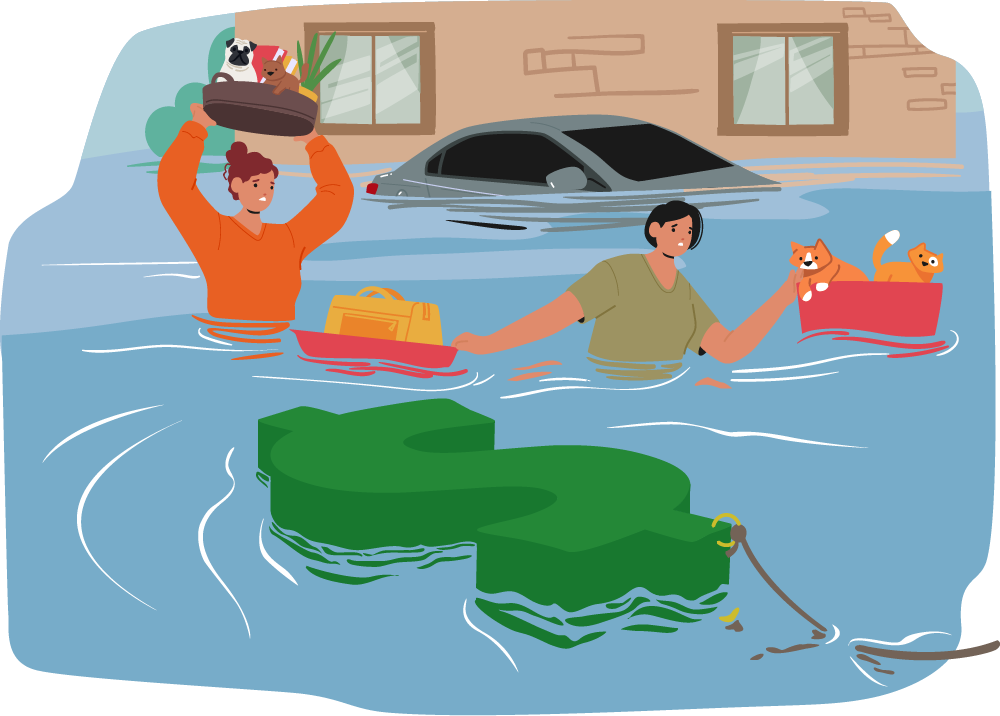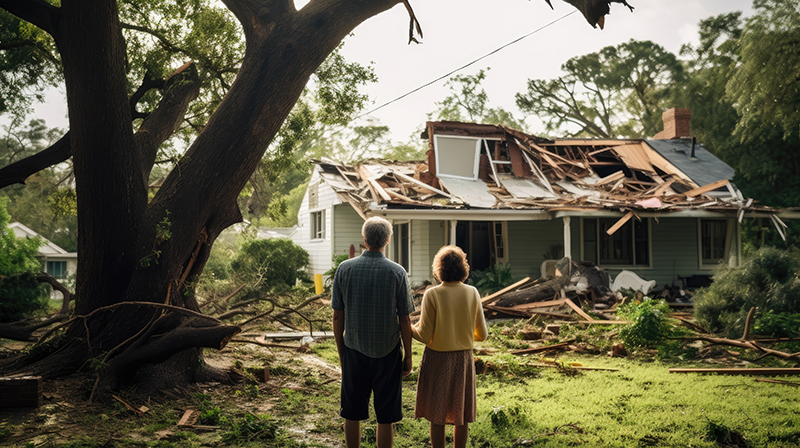What are Disaster Distributions from Retirement Accounts?
May, 09 2025 by Veselina Arangelova, EA
A distribution from a retirement account can be a lifeline for those affected by a natural disaster. These distributions provide financial relief to help rebuild and recover from the devastating impacts a hurricane or flood can have on people’s daily lives. In this blog, we will explore disaster distributions, whether you need to repay them, and other tax implications you might want to consider before requesting a withdrawal.
What is Disaster Distribution?
A disaster distribution is a special type of withdrawal from a retirement account, such as a 401(k) or an Individual Retirement Account (IRA), that is allowed under specific circumstances related to federally declared disasters. These distributions are designed to provide much-needed financial assistance to individuals who have suffered a significant loss due to natural events like hurricanes, floods, wildfires, or earthquakes.
When a natural disaster occurs, the Internal Revenue Service is responsible for providing tax-specific guidance to taxpayers. That often includes extended deadlines for filing required returns and making tax payments. In prior years, the IRS also provided guidance for special distributions from retirement plans and accounts, but only after Congress enacted relief on a disaster-by-disaster or year-by-year basis. The COVID-19 pandemic is an example of a major disaster, albeit not natural, that prompted Congress to vote on special rules for distributions from retirement accounts.
The SECURE 2.0 Act of 2022 (SECURE 2.0), enacted on December 29, 2022, amended the Internal Revenue Code to provide for distributions from retirement plans and accounts for any federally declared major disasters occurring on or after January 26, 2021. Under SECURE 2.0, Congress has provided ongoing guidance for disaster relief distributions rather than on a case-by-case basis.
General Rules and Requirements
For a distribution to be qualified as a disaster distribution, and not be subject to the regular or early distribution rules, some general rules apply:
- An individual must be a qualified individual. A qualified individual is one (1) whose principal residence is in the qualified disaster area and (2) who sustained an economic loss during that period.
- The Federal Emergency Management Agency (FEMA) must specify the incident period for a qualified disaster. It can be a day in the case of a tornado, or a few days or weeks in the case of a hurricane. The specific dates can be found on the FEMA website here.
- Examples of an economic loss are the loss, damage, or destruction of real property, loss of employment due to temporary or permanent layoff, or displacement from your residence.
- The President must declare the event a major disaster for it to qualify.
A disaster may initially be declared an “emergency” and, as events unfold and more information becomes available, later be upgraded to a “major” disaster. This distinction is essential because only major disasters qualify for relief under SECURE 2.0.
Disaster Distributions and Loans
The two types of disaster distribution withdrawals from qualified retirement accounts are disaster recovery distributions and disaster loans. They have different repayment limits and requirements.
What is a disaster recovery distribution?
A disaster recovery distribution is a distribution made to a qualified individual from an eligible retirement plan, on or after the first day of the incident period. The eligible period ends 180 days (about 6 months) after the first date of the incident or the date a disaster declaration is issued by the President. The maximum amount you can take from all eligible retirement accounts, including IRAs, is $22,000.
These distributions, once made, are reported by the plan custodian on Form 1099-R, Distributions From Pensions, Annuities, Retirement, or Profit-Sharing Plans, IRAs, Insurance Contracts, etc. and must be reported on your individual tax return. The amount received is taxable, but not subject to an early withdrawal penalty if you are under 59 ½. In general, the taxable amount distributed is spread over 3 years, meaning that a third of the total will be reported as income on your current year's return and the rest in the next two years. If it is financially possible, you can elect to pay the tax on the total in the first year and not worry about it in future tax years. An example will help us illustrate this point better.
 John’s home suffered substantial damage after a hurricane devastated the area where he lives. He checked the requirements and determined he was a qualified individual, so he took a disaster distribution from his 401(k) to help repair the damage. In 2022, John received a 1099-R reporting the total amount he had taken, $21,000. John includes, as income, a third of the distribution, $7,000, on each of his returns for the next three years—2022, 2023, and 2024.
John’s home suffered substantial damage after a hurricane devastated the area where he lives. He checked the requirements and determined he was a qualified individual, so he took a disaster distribution from his 401(k) to help repair the damage. In 2022, John received a 1099-R reporting the total amount he had taken, $21,000. John includes, as income, a third of the distribution, $7,000, on each of his returns for the next three years—2022, 2023, and 2024.
Disaster distributions from retirement accounts can be a much-needed lifeline, but they also reduce the amount you saved for retirement in future years. To remedy this situation, there is the option to repay some or all of the distribution over the 3-year period. It is important to note, in general, these distributions do not have to be repaid, unless you want to and can afford to repay them back into your retirement account. More details about repayment and reporting are included in the instructions for Form 8915-F. You can review them here. Let us illustrate this point with an example.
By 2024, John’s home was repaired, and he was back on track at work. He had enough money to repay the $21,000 into his 401(k) and chose to do so before the due date of his 2024 return. As a result, John had to amend his 2022 and 2023 returns to claim a refund for the tax attributable to the amount of distribution included on the two returns. John doesn’t have to report the $7,000 that should have been reported on the 2024 return since he repaid the entire amount prior to the due date of the return.
If you plan to repay what was once withdrawn, the only way to claim a refund for the tax attributable to the distribution amount is to amend the returns in which the disaster distribution has been included in total income. You can consult a tax professional if you need more help with tax preparation and planning.
What is a disaster loan?
A disaster loan is an amount you borrow from your retirement savings. A loan differs significantly from a disaster distribution in the following ways:
- the amount of money you can take from your retirement account is greater,
- the amount you borrow must be repaid, and
- there is no taxable event unless you fail to repay the loan, or you are laid off, terminated, or leave your job and cannot repay the remaining balance within a specific period.
The maximum amount you can borrow from your retirement savings depends on how much you have saved and how much of the balance is vested. In general, qualified individuals can borrow up to 50% of the total vested balance or $50,000, whichever is less. If the total balance of your account is less than $10,000, then the entire balance of the account may be loaned out. Let us use John from our earlier examples to clarify this:
John wants to borrow money from his 401(k) to help pay for the repairs to his home due to damage from a hurricane. He has a balance of $75,000 in his 401(k), and the amount is fully vested. The maximum amount John can loan out from his 401k account is 0.50 x $75,000 = $37,500.
Under SECURE 2.0, an employer may increase the dollar limit up to the maximum vested balance but not more than $100,000. The loan repayment can also be delayed by one year.
Given the impact of a recent disaster in the area, John’s employer, Company XYZ, decided to increase the maximum limit an employee can request as a loan from the retirement plan, they provide. Because of this change and the rules under SECURE 2.0, John can take up to the entire vested balance in his account, which is $75,000.
If you need to take out a loan, the plan will not report a distribution on Form 1099-R in the year you receive it. As we mentioned above, loans from retirement accounts must be repaid. You have five years to repay what you took out and you must make at least quarterly payments. If they are not repaid as agreed, the outstanding balance is reported, in the year of default, as a taxable distribution. Before you request a loan withdrawal, consider your options, and consult a professional if you need more information or guidance based on your unique circumstances.
Conclusion
Individuals affected by natural disasters often must dip into their retirement accounts to fully recover. While these distributions offer relief, it is crucial to understand the repayment obligations, if any, and eligibility criteria. By staying informed and seeking guidance from professionals, you can navigate the complexities of disaster relief and make more informed decisions to aid your recovery.
If you have been impacted by a natural disaster and want to learn more about other tax-related disaster relief provisions, check our recent blog about Hurricane Milton and Helene here. If you worry you may receive a notice because of disaster distribution or any other tax issue, check out our membership page for more information about our audit services.




